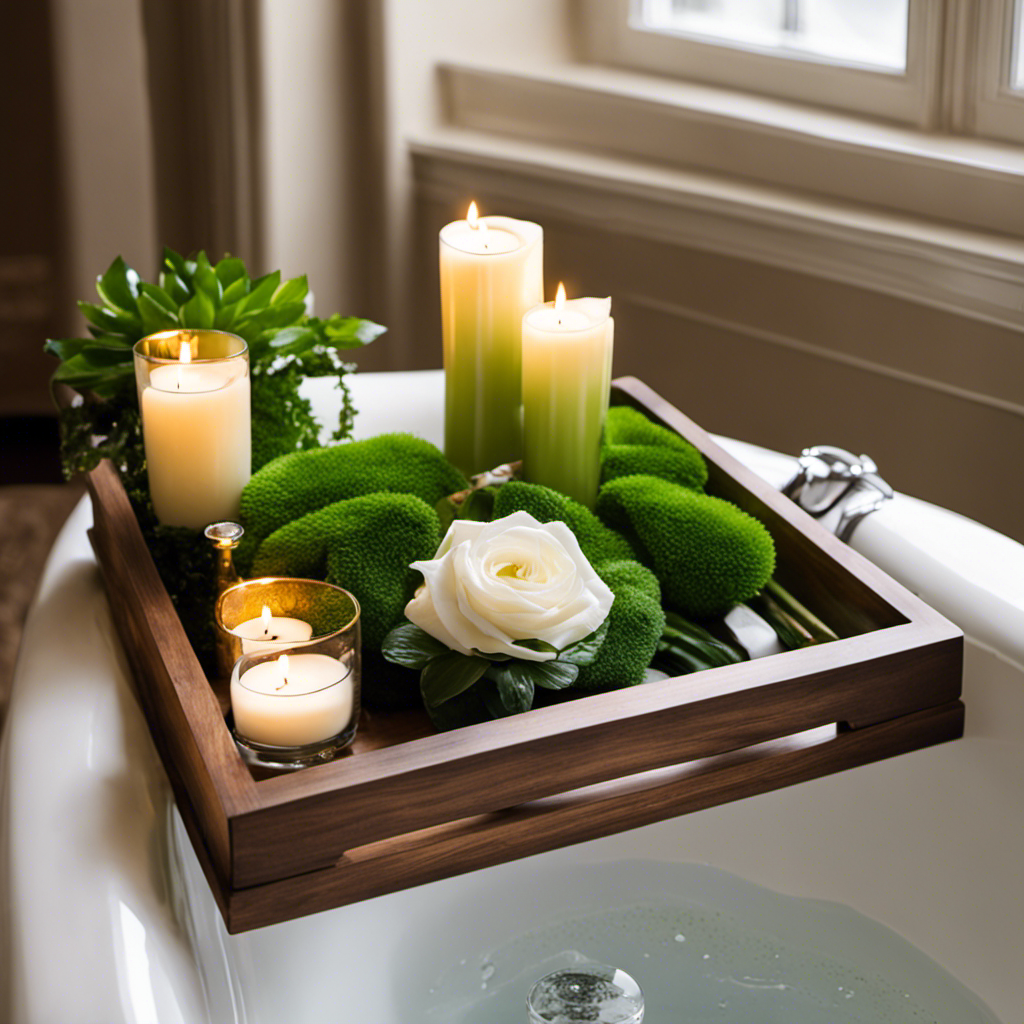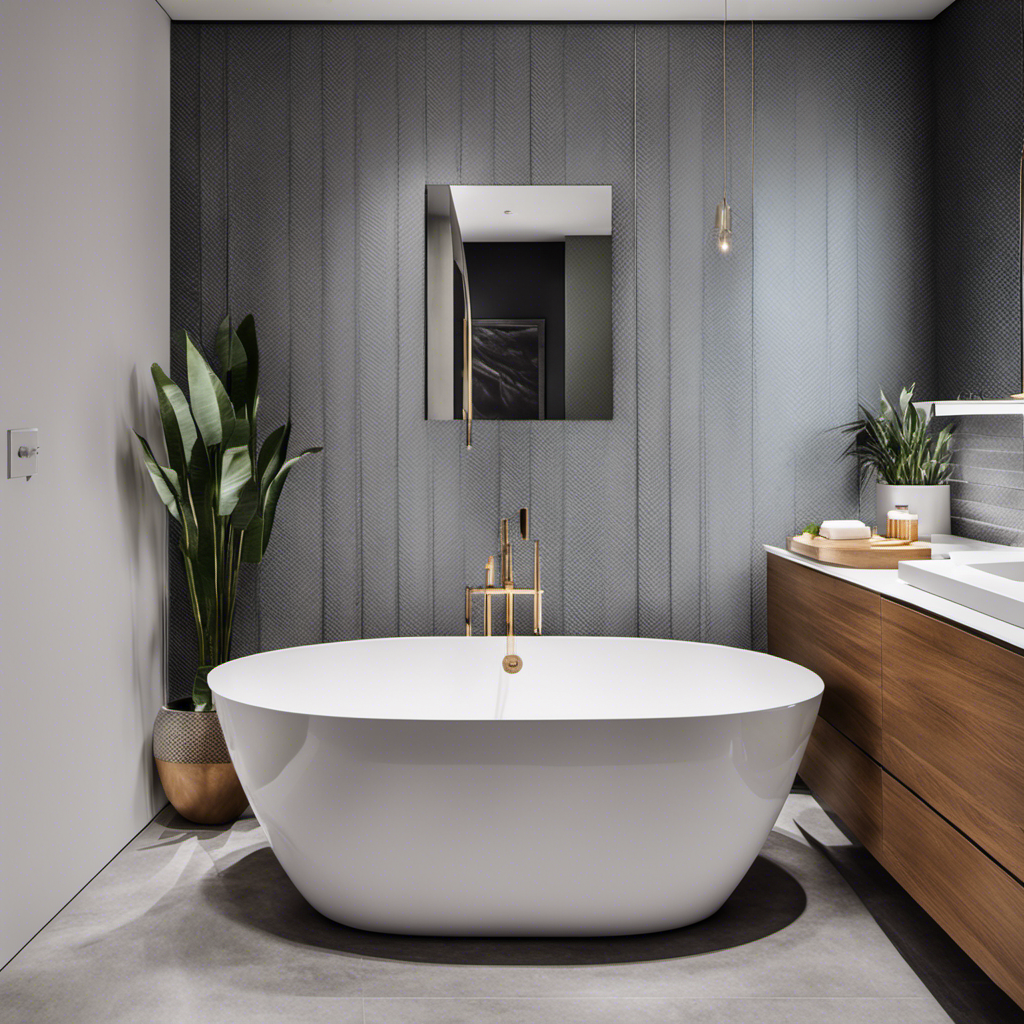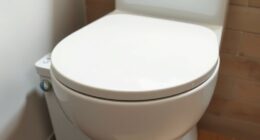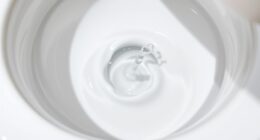Are you ready to transform your dull bathtub surround into a stunning masterpiece? Look no further!
In this article, we will guide you through every step of the tiling process, ensuring that you achieve professional results. From choosing the perfect tiles to applying the thinset with precision, we’ve got you covered.
Get ready to impress your friends and family with your expert-level tiling skills. Let’s dive in and create a bathtub surround that will leave everyone in awe!
Key Takeaways
- Consider the overall style and feel of your bathroom when choosing tiles for your bathtub surround.
- Subway tiles and mosaic tiles are popular choices for a classic and timeless design or a more intricate and unique look, respectively.
- Choose tiles that are easy to clean and resistant to moisture, such as porcelain or ceramic tiles.
- Properly prepare the surface by applying a high-quality primer, using a waterproofing membrane or sealer, and ensuring accurate measurements for a professional-looking tile installation.
Choosing the Right Tiles for Your Bathtub Surround
Now, you’ll want to take a moment to consider which tiles are the best fit for your bathtub surround. When it comes to tile design trends, there are countless options to choose from.
As a tile installer, I would suggest considering the overall style and feel of your bathroom to ensure a cohesive look. Subway tiles are a popular choice for a classic and timeless design, while mosaic tiles offer a more intricate and unique look.
In terms of cleaning and maintenance, it’s important to choose tiles that are easy to clean and resistant to moisture. Porcelain and ceramic tiles are excellent choices as they are durable and require minimal maintenance. Remember to always follow the manufacturer’s recommendations for cleaning products and techniques to maintain the longevity of your tiles.
Preparing the Surface for Tiling
Before you start tiling, make sure to properly clean and prime the surface. This step is crucial in ensuring a successful tile installation on your bathtub surround. Here are four important things to keep in mind:
-
Priming Walls: Apply a high-quality primer specifically designed for tile surfaces. This will help create a strong bond between the tile and the wall, ensuring long-lasting results.
-
Waterproofing the Surface: Use a waterproofing membrane or sealer to protect the underlying wall from moisture. This is especially important in areas prone to water exposure, such as the bathtub surround.
-
Precision Measurement: Accurate measurements are key to achieving a professional-looking tile installation. Take the time to measure the area meticulously, ensuring that the tiles will fit perfectly.
-
Proper Tile Placement: Start from the bottom and work your way up, placing the tiles in a staggered pattern. Use tile spacers to maintain even spacing between tiles and ensure a uniform look.
Installing the Tile Backer Board
Make sure to properly attach the tile backer board to the walls, using screws or nails for a secure installation. Before installing the backer board, it’s important to apply a waterproof membrane to protect the underlying structure from water damage. This membrane acts as a barrier, preventing moisture from seeping into the walls. Once the membrane is in place, measure and cut the backer board to fit the wall dimensions. When cutting the backer board, use a utility knife or a power saw with a carbide-tipped blade for clean and precise cuts. Fit the backer board snugly against the walls, ensuring there are no gaps or spaces. Secure the board to the studs using rust-resistant screws or nails, spaced about 8 inches apart. Remember, precision and accuracy are crucial at every step of the installation process to ensure a successful and long-lasting tile surround.
| Materials | Tools |
|---|---|
| Waterproof membrane | Utility knife |
| Backer board | Power saw |
| Screws or nails | Measuring tape |
| Rust-resistant screws/nails | Level |
Applying Thinset and Setting the Tiles
To apply thinset and set the tiles, you’ll need to use a notched trowel to spread the thinset evenly on the backer board. Here are some tips for achieving a smooth thinset application and common mistakes to avoid when setting tiles:
-
Use the right size notched trowel: The size of the trowel determines the amount of thinset that is applied. Too much or too little can lead to uneven tile placement.
-
Work in small sections: Apply thinset to a small area at a time, about 3 to 4 square feet. This prevents the thinset from drying out before you can set the tiles.
-
Press the tiles firmly: Once the thinset is applied, press the tiles firmly into place. Use a level to ensure they are straight and aligned.
-
Clean up excess thinset: After setting the tiles, check for any excess thinset that may have squeezed out between the tiles. Remove it before it dries to achieve a professional finish.
Grouting and Sealing the Tile
Now that the tiles are set in place, it’s time to grout and seal them to complete the installation. Grouting is an essential step in tiling a bathtub surround as it not only enhances the appearance but also ensures the durability of the tiles. Proper grouting techniques are crucial to maintain the integrity of the installation. To help you understand the process better, here is a table outlining the steps involved in grouting and sealing the tile:
| Step | Description |
|---|---|
| 1 | Prepare the grout mixture according to the manufacturer’s instructions. |
| 2 | Use a grout float to apply the grout between the tiles, making sure to fill all the gaps. |
| 3 | Remove excess grout with a damp sponge, working diagonally across the tiles. |
| 4 | Allow the grout to dry for the recommended time before applying a sealer. |
| 5 | Apply the sealer to protect the grout and tiles from moisture and stains. |
Frequently Asked Questions
What Are the Different Types of Grout Available for Tiling a Bathtub Surround?
There are different types of grout available for tiling a bathtub surround, each with its pros and cons. The best type for your situation depends on factors such as moisture exposure and tile spacing.
Can I Use Regular Wall Tiles for a Bathtub Surround, or Do I Need Special Tiles?
You can use regular wall tiles for a bathtub surround, but using special tiles has benefits. Special tiles are designed to withstand moisture and provide better protection against water damage.
How Long Does It Typically Take for the Thinset to Dry Before I Can Grout the Tiles?
Typically, thinset takes about 24-48 hours to dry before you can start the grouting process. It’s important to allow enough drying time to ensure the tiles are securely in place before moving forward.
Can I Install a Bathtub Surround Over Existing Tiles, or Do I Need to Remove Them First?
You can install a bathtub surround over existing tiles, but it’s recommended to remove them first for better adhesion. It’s important to be precise and accurate when measuring, cutting, and placing the tiles for a successful installation.
What Are Some Common Mistakes to Avoid When Tiling a Bathtub Surround?
Common mistakes to avoid when tiling a bathtub surround include improper waterproofing and sealing, not properly leveling the tiles, using the wrong adhesive and grout, and not allowing enough time for the thinset to dry before grouting.
Conclusion
So there you have it, a detailed guide on how to tile your bathtub surround. Remember, precision and accuracy are key in this process.
As a seasoned tile installer, I can assure you that using the right materials, tools, and techniques will result in a successful installation. Don’t be afraid to use technical language and terminology – it’s all part of the trade.
Drawing from my years of experience, I can offer practical advice and solutions to any challenges that may arise.
Happy tiling!










